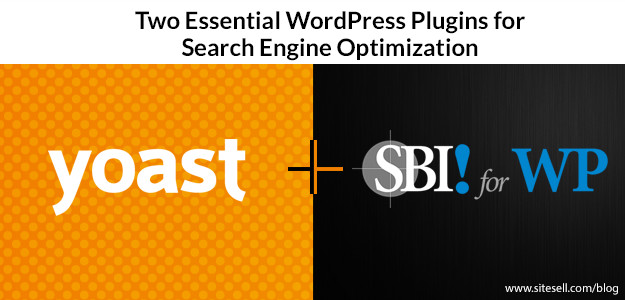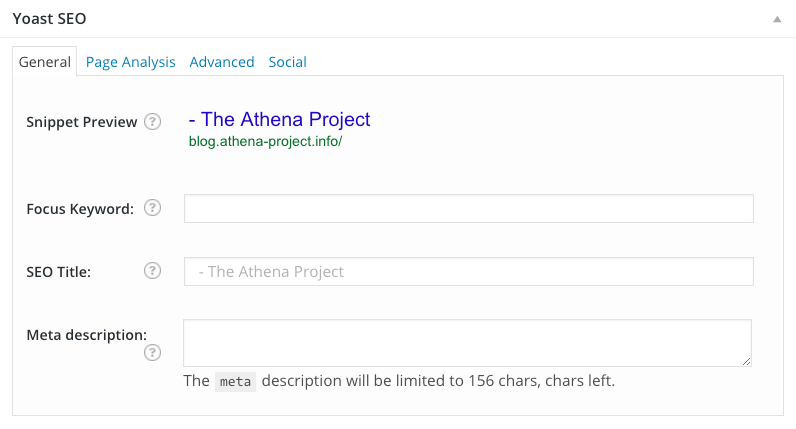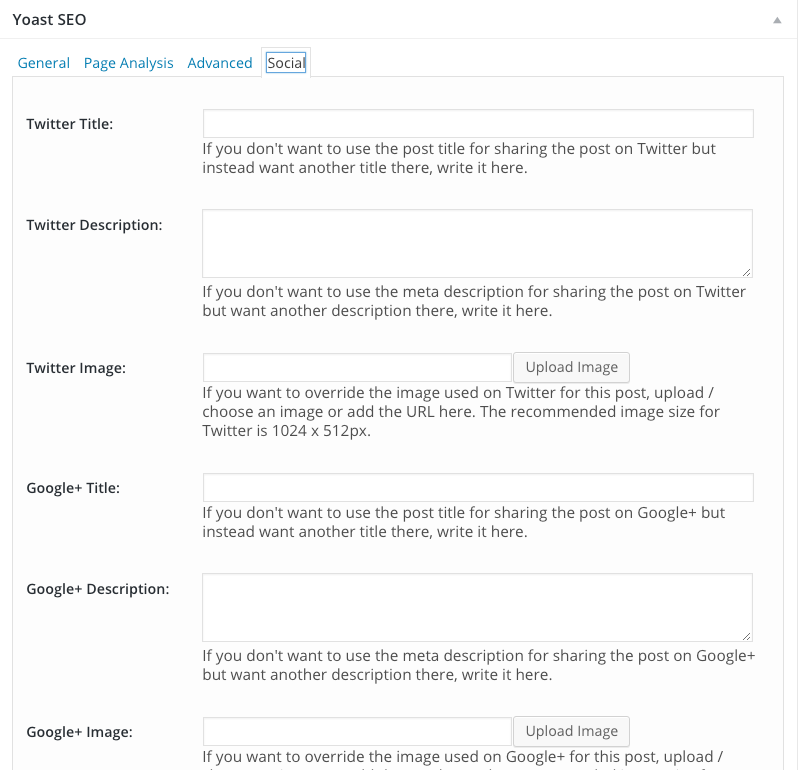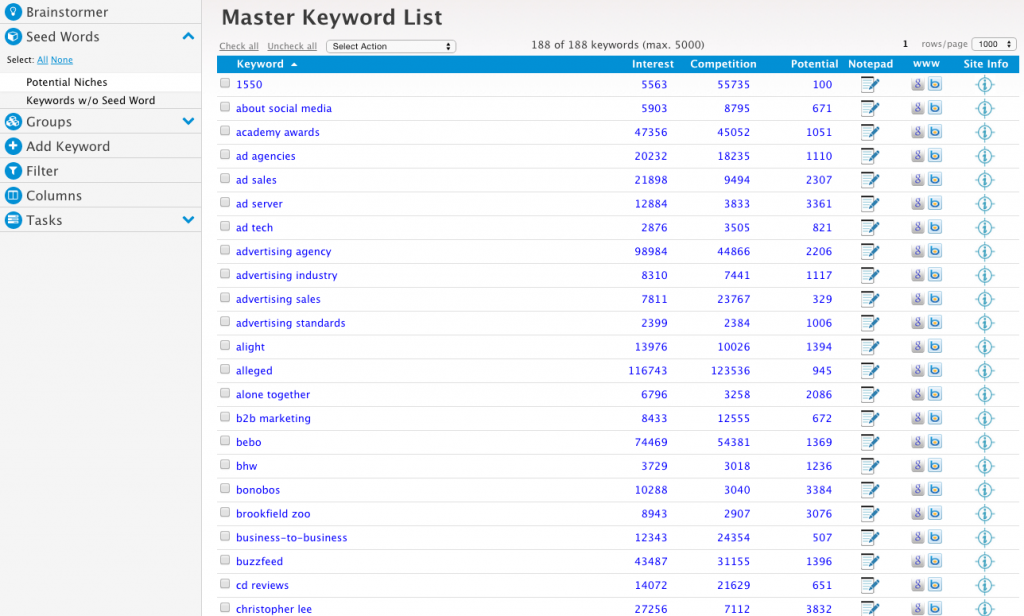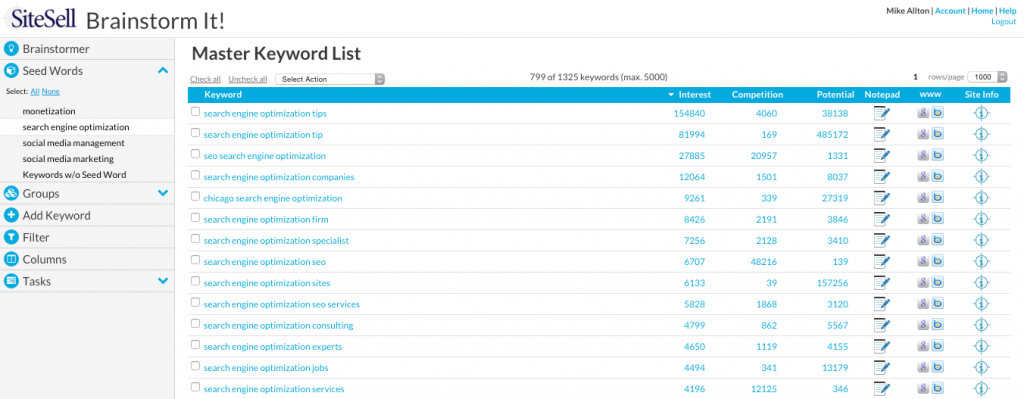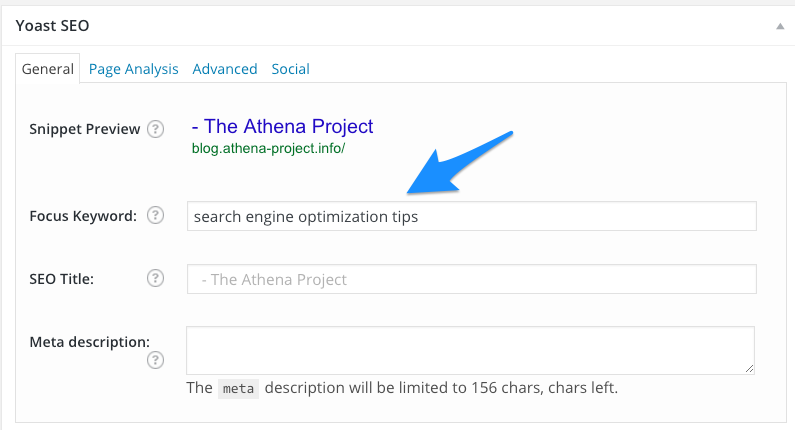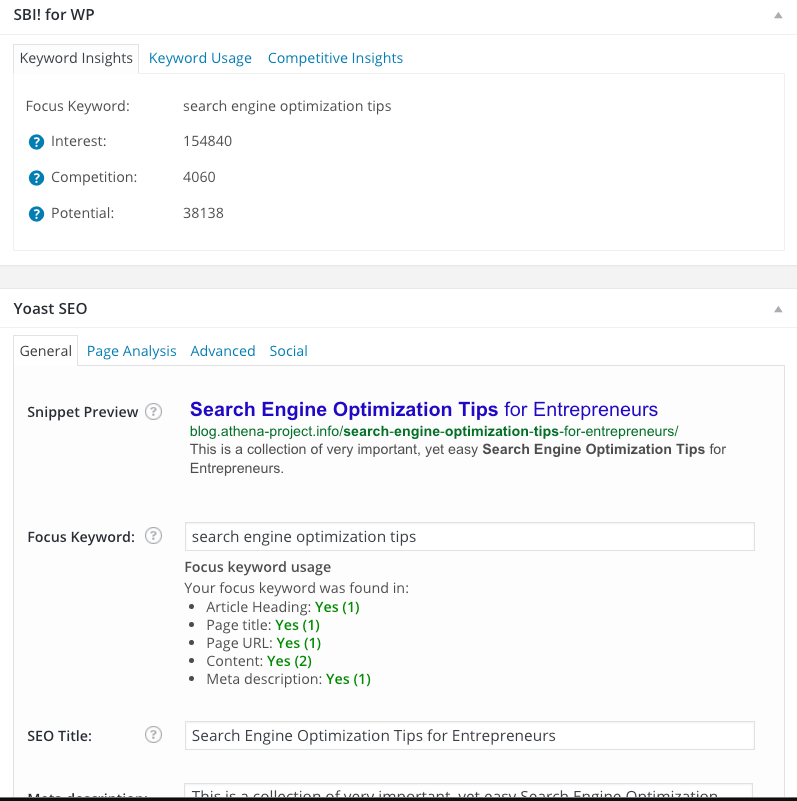If you’re creating an Online Business and depending on search engines to drive traffic to your content, Search Engine Optimization should always be in the back of your mind. Understanding what your audience is searching for, and making sure that the content you create is aligned with that specific need is paramount.
In fact, that’s why SiteSell spends so much time underlining the importance of good keyword research. If you don’t take the time to learn the tools and analyze the data up front, your site and business will fail to reach the audience you hope for.
But after you’ve done the research, there are still some mechanical elements that have to take place on your site to make sure your content is focused and attractive to search engines. This is often referred to as “Technical SEO” and is something that is handled with the assistance of one or more plugins.
But just try doing a plugin search on “SEO” at WordPress.org and you will literally get 1000+ results (WP stops counting at that point). Since you can’t filter by ratings or any other criteria, how are you supposed to know which plugin or plugins to install?
Obviously, there’s where this article comes in.
Not only am I going to share with you two amazing plugins that will help you make sure that your content is optimized for search engines, I’m also going to share how you can use these two plugins together.
Ready? Let’s get started.
Yoast SEO
Free/Premium | Website | Plugin Download
If you’ve been around other WordPress users, or read other articles on SEO, you’ve likely heard of Yoast’s plugin. It’s been one of the most popular plugins for WordPress SEO for years, and for good reason.
Not only does the plugin include full support for the “meta stack” and other SEO options, Yoast, the developer, continues to monitor and stay on top of developments in this area. When there’s a change or new capability released, you can count on Yoast to have an update shortly thereafter that makes the Yoast SEO plugin compatible.
But what does it do, exactly?
Once you install the Yoast SEO plugin, it adds to your WordPress site a number of configuration options, primarily: Sitewide and Per Post. You will be able to add default settings and adjustments that apply to your entire website, and you will be able to edit meta tags and other fields for specific posts so that they’re customized.
Meta tags are fields of information that you complete about your page or post or site, but that are not visible to readers. They’re scanned and read by search engines, and exist only in the page’s source code.
For instance, when you draft a new blog post, below the text field for your post, you’ll find a block for Yoast SEO that looks something like this:
There are several tabs that you can click through to adjust the individual settings for that particular post, including a unique Description or Title.
This is what makes Yoast SEO a critical component of any successful WordPress site.
For every Page and Post in your site, you need to be unique and deliberate with your tags and information. These meta tags are what help search engines to understand and correctly position your content.
The meta tags themselves will not help your site rank higher, but they will make your site and ranking efforts more effective.
- The Title tag is the text that is displayed in the browser bar, as well as the title within search result snippets. (More on that in a moment.) It’s an excellent place to use the keyword that you want to target primarily.
- The Description tag is the text that is displayed below the title in search result snippets. While using keywords here will have no bearing on the post’s search engine ranking, the description is a place to make your listing more enticing to the searcher.
- The Social tags will make your content more easily shared and more effectively displayed on social media, which can lead to more social shares. As search engines take such social signals more and more into account, the need to optimize social media activity becomes more important.
Take Twitter, for example. Within Yoast SEO, you can specify an alternate Title and Description for Twitter, as well as upload a specific image formatted for Twitter (ideally 1024 x 512 px). This is important because the Twitter Title can be modified to include hashtags or even @mention other Twitter users.
And with Yoast SEO installed and configured, you can also take advantage of “Twitter Cards” which show additional information automatically on your tweets, similar to link previews on other networks (post title, image and description).
Therefore, whenever you or anyone else tweets a link to your latest blog post, the tweet has more potential to be seen and engaged with, perhaps leading to additional tweets and retweets. Since Google is now indexing tweets and paying attention to how often other people share your content on Twitter, this kind of activity is definitely good for SEO.
By taking a few extra moments to complete these fields, you can dramatically increase the potential for your site and content to rank higher in search engines, bringing in more traffic, more social shares, and continuing the cycle of returns.
Now, let’s shift gears for a moment and look at a different plugin that will help you with some of the initial legwork.
SBI! for WP
Free Trial | Website
We talked a moment ago about the importance of using the Yoast SEO plugin for targeting a specific keyword in your content and metadata. But how do you actually find that keyword?
That’s where SBI! for WP comes in.
SBI! for WP does quite a few things for online businesses, including keyword research using the Brainstorm It! tool. That means that, instead of guessing which keywords to target with your content, you do some research up front to find exactly what word or words people are searching on that relates to your business.
You might discover services to offer, solutions that are needed, or information that could be provided.
The Brainstorm It! tool walks you through the process of brainstorming keywords that you think people are searching on, and then analyzing the data to see if they actually are. And at the same time, the tool shows you how much competition there is for those keywords, giving you an opportunity to decide whether or not it’s a good idea to focus on them.
Keyword Research is a fairly complex process of brainstorming, analyzing and winnowing of words and phrases. While we’ve talked about it several times in past posts, we’re working on a more extensive Guide to Keyword Research to be released within the next few weeks.
In the meantime, here’s a primer on Keyword Research and how the Brainstorm It! tool within SBI! for WP gets you where you want to be.
First, it starts with one or more ideas you might have on what topics people are searching on. These are your ‘seed words’ and they’re what get you started. More than just seeing how those specific words perform, you want ideas on what other words and phrases are out there that might be of interest.
This is one area in which Brainstorm It! is superior to other tools like Google Keyword Planner. With Keyword Planner, you get great information and data on the words you research, but it’s pretty much up to you to come up with the ideas.
With Brainstorm It!, you can get hundreds and hundreds of additional keywords that contain or are related to your initial seed words.
Some might make sense and be great topics to write about, while others might not. When it comes to search and keywords, there are often results that make little sense to us, but are appropriate for other people searching under a different context.
So as we brainstorm more keywords, we have to delete the results that aren’t appropriate or aren’t worth pursuing, and look for the opportunities.
For instance, if I was interested in writing about SEO-related topics, I might brainstorm “SEO” or “Search Engine Optimization.” If I did, I’d get a set of results like this:
Notice that I’ve used the Sort option within Brainstorm It! to show me those keywords with the highest amount of interest at the top – these are the keywords that have the greatest amount of searches and queries being performed month after month.
And I find that “Search Engine Optimization Tips” is a keyword that has a tremendous amount of interest, yet not too much competition, making it a very high potential keyword phrase indeed. Similarly, “Search Engine Optimization Tip” is also a very attractive keyword, and it seems like it would be relatively easy to create a rich piece of content that might rank well for both those terms. Something that I would not have realized on my own. (And I hope my content writers are making a note of this for next month’s SEO topic.)
As I perform searches like this, I can keep the promising keywords and delete those that are of no interest or value, resulting in a Master Keyword List (or MKL) filled with keywords that I know people are interested in.
Which brings me to the second area in which Brainstorm It! is superior to Google Keyword Planner, and that’s the Master Keyword List itself. Instead of having to start over every time you want to do more keyword research, every keyword you Brainstorm, and all of the results, are automatically saved to your MKL for easy future reference.
Now, any time I start a new Page or Post within my WordPress site, I can target one of those keywords from my MKL and pull in all of that keyword’s data:
- Interest
- Competition
- Potential
- Keyword Usage – where else within the site I’ve targeted that keyword
- Competitive Insights – the top ten sites ranking for that keyword, plus ten related sites for each of those
SBI! for WP helps me make sure that I’m targeting a keyword phrase that will actually help me bring in targeted traffic to my site and business. And with the plugin’s help, I can easily identify other posts I’ve written that I can include deep links to, as well as external sites that might actually be great external resources to link to.
Yoast SEO & SBI! for WP Achieve SEO Success Together
Now that you’ve been introduced to both plugins and have set them up within your WordPress site, let’s take a look at how they actually work together.
First, to be clear, there’s no conflict between these plugins, and they are not mutually exclusive. You can install and use both plugins within your site because, as you’ve seen, they have completely different functions.
However, when used in tandem, Yoast SEO and SBI! for WP are extremely powerful SEO tools.
Starting with SBI! for WP, make sure that you’ve done your research and found some specific keywords to target. You’ll need to have at least one keyword in your MKL.
Once you’ve started a new Page or Post, use the SBI! for WP Keyword Insights block to begin typing in the keyword that you want to target for that post. If you haven’t added it to your MKL yet, you can actually add it on the fly here, though it’s recommended that you use the Brainstormer to do your research in advance.
As we mentioned before, this will verify for you the Interest, Competition and Potential for that keyword, as well as provide you with Keyword Usage and Competitive Insights.
Next, head over to the Yoast section below the content field and enter your targeted keyword phrase into the Focus Keyword field. This will let the Yoast SEO plugin know that this is the keyword you wish to target.
Once you’ve composed your page or post, Yoast SEO will tell you exactly how well you did with integrating that keyword into your post. Like this:
For the purposes of this example, I wrote some content around “Search Engine Optimization Tips” and made sure it was in the Title and Description, within the post copy, of course, and elsewhere.
Yoast SEO also includes a Page Analysis tab that gives you even greater insight into how you did and improvements you might need to make.
Together, Yoast SEO and SBI! for WP will help you to target the right keyword phrases with your content, ensuring that your posts and pages are found within search and rank well. This will bring you and your business more traffic, leads and sales.
For more information on SBI! for WP, and to sign up for your free trial, head over to https://www.sitesell.com/SBIforWP.
NOTE: Those of you using SBI! already have the benefit of Brainstorm It! to help you research keywords and focus on a targeted word or phrase for your content. And you can add whatever Meta Tags you wish to your page header within Site Builder.
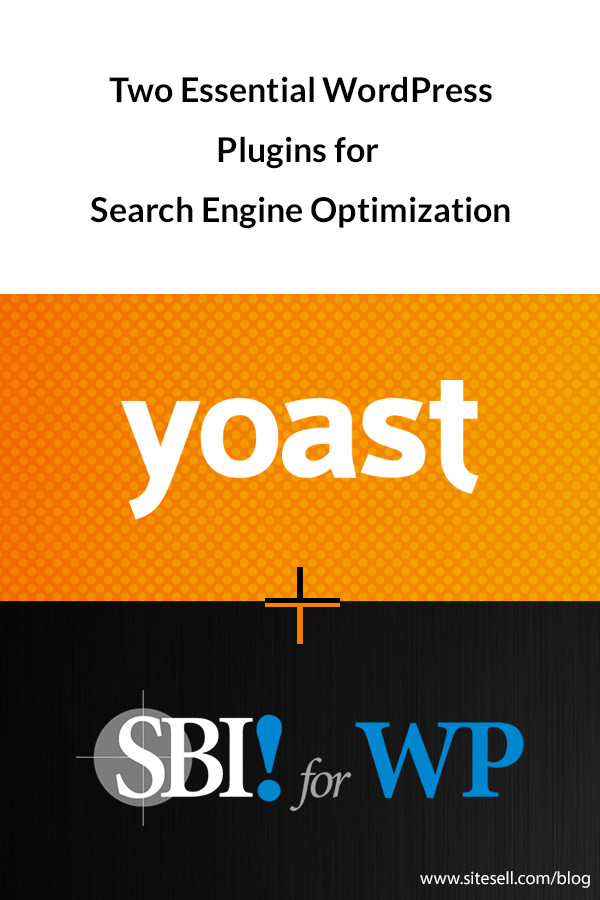
Latest posts by Mike Allton (see all)
- How to Avoid Failure in an Entrepreneurial Business - September 23, 2019
- How to Use Buffer for Social Media Management: The Solopreneur’s Guide - September 15, 2019
- Wix Review: An In-Depth Comparison of 10,000 Websites - September 1, 2019

